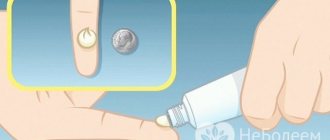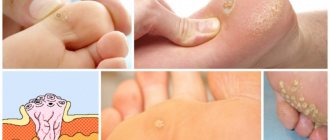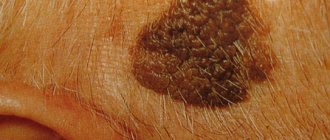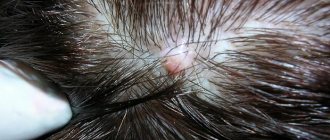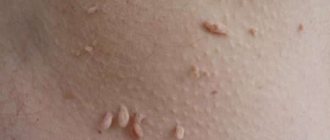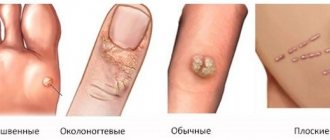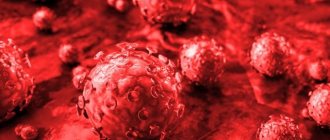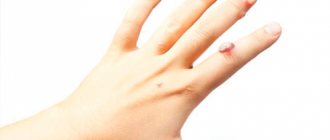Why do growths form on the toes?
The definition of “growth” is not a specialized term, so this concept hides a variety of diseases and the causes of their occurrence.
Inflammatory formations can affect the feet and phalanges of the fingers in the following ways:
- Insufficient disinfection in baths, swimming pools, and public showers causes growths of the viral type.
- Microcracks and wounds on the legs and arms through which bacteria, for example, the human papillomavirus, enter.
- Neglect of body hygiene standards leads to the breeding of bacteria and increases the chance of infection.
Damage to bone and cartilage tissue occurs due to the following factors:
- Small shoes and too high a heel lead to deformation of the metatarsal bone.
- Flat feet contribute to the development of bunions.
- Obesity or later pregnancy increases the stress on the legs and feet.
- With age, both the immune system and the human skeleton weaken, which gives a higher percentage of neoplasms.
- Sometimes the problem of growths in a person is hereditary.
Diagnosis of growths and which doctor to contact?
Before prescribing treatment for lumps and growths, it is necessary to find out the patient’s symptoms.
First of all, anamnesis is used - a patient interview conducted by an orthopedist or surgeon. If the problem does not lie in bone pathology, treatment is carried out by a dermatologist. During the conversation, it is important to find out complaints, possible predispositions, causes, and also how long the patient has been worried about it.
For mild forms of bacterial infections and the initial stage of bone growths, treatment is prescribed by a doctor without additional diagnostics.
But for a full-fledged study, the patient may be prescribed instrumental studies:
- X-ray stop. Three types of projection allow us to examine existing deviations and deformations of the metatarsal bones, toes, as well as pathologies in the bone processes.
- Computer plantography. A specific photo of a footprint. Allows the attending physician to identify pronounced pathologies and improper distribution of the load on the legs.
- Computer podometry. Gait studies on technical devices reveal the first stages of growths on the toes and feet.
- Biomechanical studies. Fixation of pathology expressed by reduced bio-activity of the interosseous muscles of the foot and toes, which manifests itself even in the first stages of the disease.
How to treat warts
Before undertaking any treatment, you need to make sure that the problem really exists and know how to treat warts. After all, a wart on a toe may turn out to be an ordinary mole. Therefore, you need to see a doctor who will determine what kind of tumor is on your body and prescribe treatment.
How to get rid of papilloma in the hospital:
- you can remove the formation using a laser;
- Surgery will help remove a wart on a finger;
- electric current will help get rid of papilloma without damaging the nail;
- using nitrogen, which will help remove the formation even on the little toe.
Types of growths on the toes
In pathologies of the feet and toes, there are the following types of bumps, both caused by bacteria and bone deformation.
Bacterial growths and skin growths due to infection:
- Warts: common, periungual and plantar.
- Hard and soft fibroids.
- Corns.
- Nevus.
- Seborrheic and actinic keratoses.
Skeletal deformity:
- Valgus foot.
- Interdigital erosion.
- Tofus.
- Hygroma.
- Sarcomas are malignant tumors.
They all differ in appearance, method of formation, painful and tactile sensations and the severity of the pathology.
Growth on the big or middle toe
Dermatofibroma:
- A fairly common occurrence that looks like a hard pink or reddish bump. It is distinguished by a pit that appears when hardened skin is collected.
- When the field of formation becomes too wide , a tubercle appears in the middle of the growth. If not treated in a timely manner, there is a risk of developing sarcoma.
- Such a bump appears for various reasons: splinters, insect bites, stagnant pustules.
Dermatofibroma on the leg
Nevus:
- In appearance it resembles a soft brown bump , sometimes flesh-colored.
- Papillomas may appear on the surface ; less commonly, a complex nevus is distinguished by a rim around the growth.
- The reason is an excess of pigment in the skin. This often appears from prolonged and frequent exposure to the sun.
- There is a predisposition to nevus , sometimes it appears immediately after birth.
Valgus deformity:
- Expressed by a protruding bone at the base of the big toe. Here the shape of the joint changes, although in the first stages only calluses appear.
- It is detected as a result of women constantly wearing shoes with high heels or shoes with completely flat soles.
- Both cases lead to flat feet, and, as a result, hallux valgus deformity may appear.
Hallux valgus deformity of the big toe joint
A growth or callus between the toes
Interdigital erosion. It appears and multiplies between the fingers, since it is easiest for fungal infection to remain there.
Inflammations and ulcers appear at the sites of erosion, which heal and turn into a compacted callus.
The more complex and longer the fungal disease lasts, the more often and more unwanted hard calluses appear. Appears most often in people with diabetes and excess weight.
Callus and warts on the toe
Types of warts or calluses:
- Plantar warts. The growths look like compacted flat yellow calluses between the toes and on the pads of the fingers. When small in size they are called spines. When touched strongly, they hurt, which makes it difficult to walk normally. It differs from corns by the asymmetry of its location on both feet.
- Periungual warts. This type of growth differs in color (darker colors, from yellow to brown) and structure (more uneven). They are dangerous because they can disrupt the proper growth of nails.
- Calluses appear most often on the bend of the ring finger, middle finger, and also on the side of the little finger. A callus is a protection of the skin from constant friction.
Corns
Dry calluses that feel like calluses are called corns. The cause of their occurrence is compaction of the epidermis as a result of constant rubbing and pressure. This reduces blood circulation in the legs and leads to dead skin.
The most common reason is uncomfortable or small shoes. The most common place for corns to appear is the little toe and big toe; less commonly, they occur between the toes due to flat feet.
Types of warts
There are several types of warts recognized:
- A vulgar wart or, as I also call it, an ordinary wart. This wart looks like a small round growth that looks like a callus filled with water, but is dense to the touch, you might think that it is just an internal callus in the deep layers of the skin. Such growths can be seen on the hands and fingers, and if they occur in children, they can be located on the knees. These warts are not dangerous and disappear on their own, especially when they appear at a young age.
- Flat warts, or as they are also called, juvenile warts. As the name implies, such skin formations occur in adolescent children. They have clear boundaries and irregular shape. They protrude low on the surface of the skin, no more than 2 ml in height. Such growths can form on the face, neck, lower legs, and in rare cases on the penis.
- Plantar warts, or as they are also called chicken warts, most often such warts form as a growth on the big toe. A person’s foot, that is, the entire foot as a whole, can suffer from these growths. These are gray or yellow warts that are smooth at the initial stage and then become rough. As it develops, a foot grows from the core of the wart; the wart does not grow above 2 ml in height, so it does not have a foot. Such a growth on the toe, with further growth, begins to resemble cauliflower. Every person who has suffered from such a problem is concerned with the question of how to get rid of a wart on a finger. But more on that below.
- Filiform warts, or as they are popularly called, papillomas. Such growths are most often small in size and are located on the face, under the breasts, in the armpits, and sometimes in the groin area. Such growths can be easily removed by surgery or freezing.
- Genital wart or, as it is also called, genital wart. As is already clear from the name, these neoplasms most often occur on the genitals. They can also be seen inside the anus, on the urinary tract and in the mouth. Such warts are transmitted, to the great horror, through sexual contact.
- Senile or recurrent warts. These skin growths have nothing in common with the previous types. The human papillomavirus has no effect on the appearance of such growths. Their consequence is senile skin changes. This occurs from exposure to sunlight and is also due to heredity.
Condyloma acuminatum is sexually transmitted
Growths on a child's toe
In children, spines or warts are most often diagnosed - penetration of the human papillomavirus under the skin.
There are many causes of infections in children:
- Newborns pick up the infection during childbirth from the mother's genitals.
- Young children often run barefoot and neglect hygiene rules.
- The child often uses other people's personal belongings.
- A weak immune system allows the virus to penetrate.
The growths look like bumps with rough skin, sometimes similar to rough spots on the legs.
The main types of warts in children:
- vulgar (simple, ordinary);
- flat (adolescent, juvenile);
- plantar;
- periungual;
- molluscum contagiosum (variola virus group).
With timely treatment, the growths do not become dangerous or malignant. The bacteria themselves are killed in large numbers when using pharmaceutical products.
The specificity of the treatment also lies in the fact that often the child’s immunity copes with the growths on its own within 6-12 months. It is worth contacting a dermatologist if the child is confused by warts, but they themselves hurt and grow quickly.
Features of treatment in children
Warts are unpleasant and uncomfortable growths on various parts of the body. They can cause discomfort when walking, pain in the toes and feet, as well as on the surface of the entire leg.
Such warts can make many people disgusted and wary when dealing with people carrying such viruses.
Is it okay to live with warts on your feet or do they need to be removed? Your doctor will most likely recommend removing the growth. Firstly, he may get injured. Secondly, with constant friction there is a possibility of transforming the wart from a benign tumor to a malignant one.
Medical procedures and official treatments:
- Cryotherapy. The wart between the toes is cauterized with liquid nitrogen. There are no scars left.
- Laser coagulation. Cauterization leaves only a small dent at the site of the growth. It is considered the most modern and effective method of treating warts.
- Electrocoagulation. Unlike the previous one, it leaves scars on the skin. The impact occurs with a high-frequency current discharge.
- Operation. The surgeon removes the growths under local anesthesia. The disadvantage of this method is that it will leave a scar.
- Vitamin therapy. In some cases, the doctor recommends certain medications to remove the wart. Ingestion of elements A and E, smearing with vitamin E at home is a safe method to cure a growth in a child or get rid of it for an adult.
- In some cases, treatment with 10% interferon ointment is effective. It activates local immunity and helps remove formations at home without unnecessary procedures.
Traditional methods of treating warts
1. Celandine.
A plant with small yellow flowers, which can easily be found in the central zone of our country, has long enjoyed the reputation of an effective remedy for growths. To remove the formation, bright yellow juice will come out of the celandine stem. They need to gently lubricate the skin around the wart a couple of times a day.
When using this method, you must remember that celandine is poisonous. Therefore, do not allow the juice to get on the mucous membranes or into the esophagus. You should not experiment and use the product on young children at home without consulting a doctor.
2. Euphorbia.
Another poisonous plant that can replace medications and help get rid of warts at home. Treatment consists of smearing the juice of the stem of the growth until its upper part darkens and dries out. After this, it is carefully cut off and the formation is further processed to remove its root.
3. Vinegar.
This method cannot be used in the treatment of children - it is better to remove the growth using the traditional method. Take concentrated vinegar essence.
A few drops are mixed with flour. The area to be treated on the fingers and toes is steamed in hot water.
Then they wipe it off, lubricate the skin around it with a thick layer of rich cream, the wart itself must be slightly wetted. Quickly apply vinegar and flour.
When the burning begins, the composition is thoroughly washed off. Such treatment at home should lead to the fact that the wart will gradually begin to dry out, turning into a crust.
You should not remove it - it will fall off on its own.
4. Dry ice.
It is possible to remove the growth with the help of a special substance, which is used, for example, in storing ice cream or when transporting medications that require refrigeration.
You can remove the unpleasant formation by wrapping dry ice in a cloth and applying it to the wart twice a day. You will have to endure the burning sensation for some time.
After a few sessions, the growth will turn black. You can get rid of it completely after a week or two of use.
It is important to be careful not to let dry ice touch healthy skin.
Preventing the appearance of growths on the toes
- Maintain personal hygiene, wear clean socks and tights, dry your shoes and wash your feet.
- Buy quality natural shoes. Make sure your feet breathe and don't sweat.
- Eat a balanced diet: regular intake of essential vitamins and minerals will allow your immune system to remain strong.
- Cleanliness in your home is also important for health: do not forget to do wet cleaning regularly and change bed linen.
- Try to lead an active lifestyle, be outdoors more often, move, and play sports.
- If you suspect a wart, do not put off visiting a doctor: he will accurately determine the nature of the formation and help you find the best way to get rid of it.
As a rule, such growths do not cause much discomfort other than psychological. However, there are times when a wart on the foot can be very painful, especially if it is between the toes or on the balls of your feet. Then they need to be removed.
How to get rid of formations of this type? We recommend seeking help from a specialist who will diagnose the disease and prescribe appropriate treatment. It may involve the use of medicines, traditional methods, as well as surgical interventions.
Medical removal
It is based on the use of special antiviral ointments (terbofen, interferon, salicylic, oxolinic and others).
You can also apply salicylic acid patches (Salipod). To ensure removal occurs as quickly as possible, these agents can be alternated.
Such a drug as Superchistotel has proven itself to be excellent. It must be used with great caution, because if it touches healthy tissue, it can leave a burn. It should not be used to treat tumors in children, pregnant or lactating women.
The advantage of these methods is that treatment can be carried out at home. However, we still recommend consulting a doctor before starting procedures.
Surgical methods
Electrocoagulation of growths. Thanks to this procedure, you can remove unpleasant condyloma on the leg in one session.
Cryotherapy or freezing with liquid nitrogen. When exposed to cold, the wart cells die, the spread of the virus is prevented, as a result of which the nodule simply disappears.
If large growths form, for example, on the big toe, laser removal may be prescribed, which will burn out the papule layer by layer.
The downside is that after such exposure a scar may remain, but still, this is better than an ugly wart.
Traditional methods of treatment
In past centuries, people removed warts exclusively using folk remedies. Note that such treatment was often effective.
The downside is that it requires patience, since the healing process takes quite a long time (sometimes up to 3 months).
You can lubricate the nodules with vinegar essence with garlic, aloe or celandine juice. Some were helped by raw potatoes, onions and even ordinary chalk.
Of course, now, with the availability of modern technologies and effective pharmaceutical drugs, it is better not to engage in such treatment. Although many older people still do not trust medicine, preferring to use only traditional methods.
In fact, everyone decides for themselves how to remove a wart from their leg. The type of treatment will depend on the size of the formation, as well as the degree of its development.
In order to remove a wart, you need to see a doctor. The patient undergoes an examination, then treatment is prescribed. In some cases, papilloma may disappear on its own, but for this you need to boost your immunity.
Treatment of growths in children
There are several ways to remove warts and bumps:
- Over-the-counter salicylic acid-based products : ointments or alcohol. Apply every day to a wart that has been steamed and cleared of keratinized skin; the results are noticeable after a month, sometimes earlier.
- Freezing with liquid nitrogen. For use only on children over 4 years of age who are able to sit still for a certain period of time. Often one procedure is enough, but if the damage radius is large, they resort to repeated freezing.
- Electrosurgery. The lump, along with the subcutaneous infection, is burned off with electric current; it is widely used to remove simple and plantar warts. Warn your child that during the procedure there will be an unpleasant smell of burnt skin - there is nothing to worry about.
- Laser. Laser removal of warts occurs when other methods have failed. After the procedure, it is necessary to increase the child’s immunity using medications with interferon.
Home treatment
How to treat warts at home depends on the size of the growths. Small warts can be removed with simple home remedies, but larger warts require special medications.
You can get rid of small growths using the following means:
- hydrogen peroxide;
- salicylic alcohol;
- boric acid.
To remove a wart, you should choose one of these drugs. A cotton swab is moistened in the chosen medicine and the body of the papilloma is treated. Treatment should be carried out daily for 10-14 days. After this period, the wart decreases in size and then disappears completely.
Special medications are used to treat large growths. These medications include:
- Super Celandine;
- Verrucacid;
- Solcoderm.
Super Celandine is one of the most affordable means for burning out growths at home. The preparation contains an alkaline mixture. The medicine is applied pointwise to the body of the wart, avoiding contact with healthy skin. When the medicine gets in, a burn develops, so the alkalis simply burn out the body of the wart, interrupting its supply from the blood vessels. A single treatment is enough to remove a medium-sized growth. If the wart is large, 3-5 days after the initial treatment you should use the drug again.
How to get rid of growths on your toes?
Each type of formation requires its own treatment.
Warts and calluses:
- If there is bloody discharge from callous formations and severe pain, you should consult a dermatologist and oncologist to rule out skin cancer.
- If the source of infection is too deep, laser removal or other cryodestruction should be used.
- If the warts are periungual , cutting off the growths yourself is prohibited: this can permanently change the correct growth of the nail.
- Simple visible warts can be removed independently using pharmaceutical products.
- Hard and soft fibroids. Dermatofibromas are quite hard, making home treatment difficult. Most often, such growths are removed surgically. Soft fibroids are removed more easily, but also with the help of medical intervention, for example, with a laser.
- Corns. With such growths, first of all, they get rid of the cause of their appearance: excess weight or uncomfortable shoes. The corns themselves, depending on their complexity, can be removed using special patches or surgically.
How to remove warts on toes at home
You can get rid of warts using different methods: minimally invasive procedures, folk recipes, medications. Many treatment methods are carried out in a hospital setting, but some can be used at home (herbs, acids, antiviral ointments). The difficulty of treatment lies in the fact that after removal the growth appears again after a while. Therefore, it is not enough to simply remove the wart; you must follow the recommendations aimed at preventing relapses.
Advantages and disadvantages of home treatment
Treatment at home has its advantages and disadvantages. The advantages include the availability of the method - for treatment you do not need to visit a hospital, the products can be purchased at any pharmacy. There are also disadvantages, of which there are many more:
- high probability of infection spreading;
- development of complications - ulceration, bleeding, addition of bacterial flora;
- frequent relapses;
- It is difficult to completely cure the disease at home.
Simple recommendations
Treatment of skin growths has two main directions - removal of the formation and prevention of relapses. To prevent the formation of new warts, the following recommendations should be followed:
- Do not walk barefoot in the pool, sauna, gym and other public places.
- Follow the rules of hygiene, use only a personal towel.
- Foot baths and wearing open shoes will help with excessive sweating of the feet.
- Wear comfortable shoes that do not squeeze or rub your feet.
- Do not use untreated manicure accessories.
Treatment with traditional methods
There are traditional medicine methods to cure growths based on the use of natural remedies:
- Baths. Soak your feet daily in a bath of hot water combined with a tablespoon of salt and 10 drops of iodine solution. Such baths will help remove and remove unwanted colonies of microorganisms and fungi on the feet.
- Apple vinegar. Wipe the growth with undiluted liquid 2 times a day.
- Celandine. Freshly squeezed celandine juice is applied to a bump or wart 2 or 3 times a day, which allows you to get rid of warts.
- Vegetable oil. Oil will help heal the tumor site. Wipe the area with dampened cotton wool until complete recovery.
- Butter and watercress. A paste of watercress juice and butter is applied to the growth several times a day.
Salt foot baths
Reviews about the treatment of growths on the legs
Rheumatologist with many years of experience and author of the website nehrusti.com. For more than 20 years, she has been helping people effectively fight various joint diseases.
Source
There are many types of warts, and many of them are localized on a person's legs.
It is not always necessary to get rid of tumors, because small growths may not bother a person at all and are not dangerous. But large formations interfere with life - sometimes they make it impossible to wear your favorite shoes. If you have a wart on your toe, there is no need to despair: there are many treatment methods.
Peculiarities
Photo of a wart on a toe
There are several features that help identify warts on the big toe or other fingers and distinguish them from other skin changes.
- The affected skin of the toes has a growth that looks like a papilla;
- The neoplasm on the leg is characterized by a dirty gray color;
- Upon careful and close examination, there are black dots on the surface of the growth. These are capillaries;
- If you feel the neoplasm, the growth, which often appears between the fingers, has a hard structure;
- The surface is rough;
- Viral toenail warts are usually oval or round in shape, and the texture is firm and fleshy;
- The growth is located in a dark-colored skin ring;
- Healthy skin around the wart has its usual natural appearance.
Causes of warts
A wart, like a mole, is a benign formation on the skin. The most common type is common (vulgar), often appearing on the toes, on the outer part of the foot.
On the bottom of the fingers you can find spines or “chicken” warts - a subtype of simple ones, which are classified as plantar warts. Less commonly, flat (subcutaneous) warts may appear on the lower extremities (more often they form on the knees and hands).
Usually growths form suddenly, for no apparent reason. In fact, this disease is infectious; it is provoked by the human papillomavirus (HPV). Once in the bloodstream, certain strains of the virus cause nodules to grow on the toes.
HPV infection occurs in public places through contact with the patient’s belongings or skin:
- in swimming pools;
- in baths, saunas;
- At school;
- in kindergarten, etc.
Skin changes do not occur immediately; the virus prefers to invade the body and subside. When a person's immunity decreases, the first signs appear. Warts can appear on the legs, on the body, and even on the face, because the virus circulates throughout the body.
Most often, growths appear in children, since in childhood the immune system does not work fully. It is also not uncommon for girls who like to wear narrow shoes to have spikes on their toes due to chafing and calluses.
A number of factors increase the risk of contracting viral warts:
- excessive sweating of the feet;
- violation of hygiene rules;
- wearing tight, constrictive shoes;
- the presence of wounds and cracks on the fingers.
Causes
Growths on the human body appear for various reasons. Most often these are small wounds, microcracks or abrasions on the skin.
You can become infected with such a virus through contact, simply by communicating with people who carry such diseases or by visiting crowded places.
Warts on the toe are formed due to the activation of the human papillomavirus. The infection enters the body through microtrauma or scratches on the legs, in contact with an object or the skin of an infected person.
In addition, the formation of such growths is caused by wearing tight and uncomfortable shoes, as well as excessive sweating of the feet.
A viral wart may not appear on the skin for a long time. This is due to the fact that HPV often simply “dormants” in the body, waiting for some kind of push.
This activator is a decrease in immunity, severe stress, or an exacerbation of any chronic diseases. It takes some time for a wart to form on the body.
You can become infected with HPV in public places where there is high humidity (swimming pools, saunas, baths). The risk of infection is especially high when wearing someone else's shoes in these places.
Since warts are the result of the action of the papillomatosis virus in the body, the reason for the appearance of these growths must be sought precisely in the routes of infection.
- in direct contact with an infected carrier;
- when visiting public places and not observing basic rules of personal hygiene.
The virus enters the body and can remain dormant for a long time, but at the slightest weakening of the immune system it begins to actively manifest itself. Thus, during colds, the virus can become more active and lead to the appearance of warts.
Factors that provoke a deterioration in the body’s protective properties can be divided into several types:
The main cause of the appearance of all the warts listed above is the human papillomavirus, which is transmitted mainly through sexual contact, but in rare cases, this virus can be introduced into the body by scratching the skin and touching the scratched area with a hand that was in contact with the patient, or simply touching the surface on which infected cells.
In addition to these methods of transmission, papillomavirus is transmitted through saliva and contact with any mucous membranes of the patient and directly with the warts themselves.
Treatment of warts on the fingers can be carried out at home, however, in order to eliminate the cause of the pathology, it is necessary to consult with your doctor. Otherwise, removing the growth will have a purely cosmetic effect, and HPV will continue to develop in the body. The underlying factors for the appearance of warts include the following:
- Decreased immunity caused by vitamin deficiency or overwork.
- Microscopic skin damage.
- Increased sweating.
- Failure to comply with personal hygiene rules.
- The bad habit of chewing hangnails and biting nails.
- Uncomfortable shoes.
It should be clarified that the human papillomavirus is asymptomatic in the body, so it is almost impossible to predict its development. In addition, infection occurs through tactile contact, for example, through a handshake.
Signs of warts on the leg
Since the neoplasms are not malignant in nature, they do not pose a threat to life or health.
But the appearance of the fingers suffers, because the growth looks unaesthetic:
- the surface is blackened, gray, brown, yellow;
- the shape is dome-shaped, oval, round, sometimes due to the fusion of individual warts - mosaic, internal (concave) spines are less common;
- the structure is dense, rough, hard to the touch;
- the outer “coating” is cracked, finely villous, with dots and papillae, rough;
- size - up to 0.5 - 1 cm, rarely more.
The localization of growths may vary. Warts often appear on the side of the little finger or near the nail - in a place that is subject to friction with shoes with a narrow toe. Due to friction, you can identify a wart on the big toe - due to the presence of microtraumas in the skin, the virus penetrates there quite easily.
A typical picture is a wart between the toes, and such a tumor always causes discomfort when wearing shoes and even pain when walking. It is quite possible to find a wart on the foot in the area where it connects with the toes - the spines usually “live” there.
The formation itself cannot hurt without the development of an inflammatory process in it, but due to compression of the surrounding tissues, pain is often felt when walking.
You can distinguish a wart from a callus by the presence of a rod - a clot of thrombosed black vessels inside it. Ordinary calluses do not have such a middle ground.
Types of formations
Even a person inexperienced in dermatology can distinguish the type of papilloma that has grown by its external appearance.
Ordinary
These warts affect the toes of children and adults alike. The growths are not painful, but it is not recommended to leave the growths without treatment or removal, as they multiply quickly. Skin cracks appear around the growths, through which infection can enter. The color range of papillomas is varied. The formations are flesh-colored, pink, yellowish, brownish in color. It is not recommended to remove warts on your fingers yourself. For successful treatment, it is advisable to consult a dermatologist and carefully follow all his instructions.
Flat
Such warts are also called juvenile warts, as they occur mainly on the feet of teenagers and young children. The flat top, up to 0.5 cm in diameter, of the growth resembles a smooth yellow plaque; the stalk of the wart is hidden deep in the epidermis. Formations appear singly or in groups. If the papillomas are located between the toes, then when squeezed, moderate pain and itching appears.
It is recommended to remove warts that cause discomfort to a person. It is advisable to carry out the procedure under the supervision of a doctor so as not to cause additional infection.
Subcutaneous
Such warts, which have roots located in the deep layers of the skin, most often affect the foot, but they also form on the fingers. Such formation must be removed first. If a papilloma grows near the nail plate, then the roots of the growth deform it, thin it and make it brittle. Circumstances create difficulties in removing the formation, but it must be done.
Treatment of pathology
The appearance of spines means that there is a failure in the immune system. When the immune system begins to work normally again, the growths are able to go away on their own.
If this does not happen, you should visit a dermatologist and get recommendations for treatment. A number of neoplasms spontaneously disappear within 1–2 years, others continue to increase in size.
At the initial stage, you can get rid of warts quickly, because their sizes are small. When the tumor has reached an impressive size, it is better to use modern methods of wart removal in salons and clinics.
It is imperative to remove a growth that:
- interferes with walking;
- hurts;
- growing too fast;
- susceptible to injury;
- bleeding;
- changes shape, shade;
- when there is a risk of infection.
When there are multiple warts on the fingers and other parts of the body, traditional medicine advises taking a course of therapy with antiviral, immunomodulatory drugs (Interferon, Viferon, Amiksin, Cycloferon). Such assistance to the body is necessary to reduce viremia - the prevalence of HPV.
Drug treatment
There are many medications that will help remove the unsightly growth. They can be bought at a pharmacy without a prescription, but it is better to purchase medications on the recommendation of a doctor.
You can get rid of the problem on your toes with the following medications:
- Solcoderm. Contains acetic, oxalic, nitric, lactic acids, quickly burns out warts.
- Verrucacid. It contains phenol and metacresol, which help remove the formation forever.
- Salicylic acid, Salipod patch. Preparations based on this keratolytic help cure warts on the legs by exfoliating their tissue.
- Super clean. Alkali products are widely used at home to treat spines and warts.
- Cryopharma. A liquid nitrogen-based drug that freezes warts. The procedure is carried out similar to what is done in salons (cryotherapy).
If the tumor is on a child’s leg, such medications are not suitable due to pain and risk of burns. Usually, ointments with an antiviral effect (Interferon, Panavir, Viferon, Oksolinovaya) are recommended for children, pregnant women, lactating women, people with sensitive skin and the elderly. Over a long course of treatment (about a month), such compositions will help remove spines and other growths on the fingers.
Mechanical removal
Surgical operations to get rid of tumors on the fingers are very rarely performed, because as a result, a scar may appear on the skin, which will interfere with wearing shoes.
Now there are modern methods of treating spinules on the toes using minimally invasive techniques:
- cryodestruction;
- electrocoagulation;
- laser;
- radio knife
Laser treatment is most often used, because such installations are available everywhere. The laser vaporizes the wart tissue and does not affect healthy skin. In 1 - 2 weeks, the skin will be completely restored, and there will be no scar left at the site of the wart, sometimes only a small spot will be present.
Folk remedies
Traditional methods of therapy for the presence of spines are low-cost, therefore they are used by many.
Here are the most popular recipes:
- Squeeze juice from sour apple. Lubricate the formation on your finger with juice three times a day for at least 2 weeks.
- Pour vinegar (9%) over a piece of onion and leave for 2 days in the dark. Then tie the bow to the site of the wart and wrap it with a bandage. Leave for 2 – 3 hours. Small warts die off in one procedure; for large ones, treatment will have to be repeated several times.
- Grate raw potatoes on a fine grater and apply the paste as a compress to the problem area. Leave overnight. Repeat every night, cleaning the spine tissue in the morning.
- Grind the garlic into a paste, apply to the growth, and cover with a band-aid. After 5 hours, remove the patch. Repeat treatment until the spine disappears.
- Collect fresh celandine and squeeze the juice from the plant. Apply it to the warts 5 times a day until completely cured (the method may take 10–20 days). You can use milkweed juice in a similar way.
- Lubricate the growth with iodine daily (3 times a day), after a few days its tissue will begin to necrotize and dry out.
When to remove growths
Photo of what a wart on a toe looks like
If you manage to find warts on your toe, you should take immediate measures to get rid of them. How to remove a wart if you know nothing about it? That's right, with the help of a specialist.
Only an experienced doctor can identify HPV and prescribe the necessary tests and treatment.
The most common form of growth that affects the foot is chicken butt. Knowing how to remove a chicken wart, you can get rid of unpleasant sensations.
If an adult or child has a growth on their finger, it may not always cause some discomfort. Often people ignore tumors. But only until the growth begins to interfere with normal life.
There are several situations when it is necessary to remove a wart on your finger:
- The growth begins to bleed;
- The neoplasm becomes significantly larger than its original size;
- The growth causes pain;
- A wart causes aesthetic discomfort.
First steps of treatment
As soon as a growth begins to worry a person, a logical question arises - how to get rid of it. To get rid of tumors caused by HPV, you need to competently and with the help of specialists. Self-medication at home is strongly not recommended. Especially if the patients are children.
To cure the disease, you need to take several primary steps aimed at getting rid of unwanted growths.
- Try to keep your feet dry. To do this, it is recommended to change your socks more often. If humidity remains high, there is a high probability that many new outbreaks will appear in the shortest possible time.
- It is necessary to treat warts on the fingers by comprehensively strengthening the immune system. HPV becomes active precisely because immunity declines. To get rid of warts on the feet, doctors often prescribe immunotherapy. This measure is often sufficient in such cases. But if the growth has formed on the fingers, there is a greater risk of injury. Therefore, proper nutrition and vitamins alone cannot solve the problem.
- Use comprehensive and individualized treatment. How to treat warts depends on each individual case. To find the best treatment methods, you need to be examined by a doctor, take tests and receive appropriate detailed answers.


